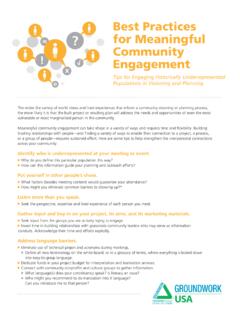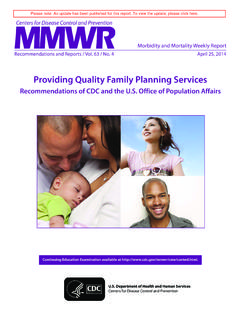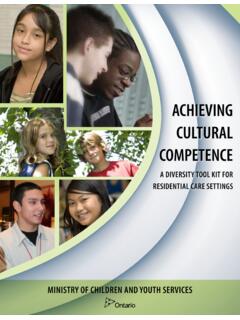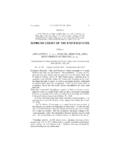Transcription of Answers to Your Questions - American Psychological …
1 AQAnswers to your QuestionsFor a Better Understanding oF sexUal orientation & HomosexUality&Since 1975, the American Psychological Association has called on psychologists to take the lead in removing the stigma of mental illness that has long been associated with lesbian, gay, and bisexual orientations. The discipline of psychology is concerned with the well-being of people and groups and therefore with threats to that well-being. The prejudice and discrimination that people who identify as lesbian, gay, or bisexual regularly experience have been shown to have negative Psychological effects. This pamphlet is designed to provide accurate information for those who want to better understand sexual orientation and the impact of prejudice and discrimination on those who identify as lesbian, gay, or is sexual orientation?
2 Sexual orientation refers to an enduring pattern of emotional, romantic, and/or sexual attractions to men, women, or both sexes. Sexual orientation also refers to a person s sense of identity based on those attractions, related behaviors, and membership in a community of others who share those attractions. Research over several decades has demonstrated that sexual orientation ranges along a continuum, from exclusive attraction to the other sex to exclusive attraction to the same sex. However, sexual orientation is usually discussed in terms of three categories: heterosexual (having emotional, romantic, or sexual attractions to members of the other sex), gay/lesbian (having emotional, romantic, or sexual attractions to members of one s own sex), and bisexual (having emotional, romantic, or sexual attractions to both men and women).
3 This range of behaviors and attractions has been described in various cultures and nations throughout the world. Many cultures use identity labels to describe people who express these attractions. In the United States the most frequent labels are lesbians (women attracted to women), gay men (men attracted to men), and bisexual people (men or women attracted to both sexes). However, some people may use different labels or none at orientation is distinct from other components of sex and gender, including biological sex (the anatomical, physiological, and genetic characteristics associated with being male or female), gender identity (the Psychological sense of being male or female),* and social gender role (the cultural norms that define feminine and masculine behavior).
4 Sexual orientation is commonly discussed as if it were solely a characteristic of an individual, like biological sex, gender identity, or age. This perspective is incomplete because sexual orientation is defined in terms of relationships with others. People express their sexual orientation through behaviors with others, including such simple actions as holding hands or kissing. Thus, sexual orientation is closely tied to the intimate personal relationships that meet deeply felt needs for love, attachment, and intimacy. In addition to sexual behaviors, these bonds include nonsexual physical affection between partners, shared goals and values, mutual support, and ongoing commitment.
5 Therefore, sexual orientation is not merely a personal characteristic within an individual. Rather, one s sexual orientation defines the group of people in which one is likely to find the satisfying and fulfilling romantic relationships that are an essential component of personal identity for many do people know if they are lesbian, gay, or bisexual?According to current scientific and professional understanding, the core attractions that form the basis for adult sexual orientation typically emerge between middle childhood and early adolescence. These patterns of emotional, romantic, and sexual attraction may arise without any prior sexual experience.
6 People can be celibate and still know their sexual orientation- be it lesbian, gay, bisexual, or lesbian, gay, and bisexual people have very different experiences regarding their sexual orientation. Some people know that they are lesbian, gay, or bisexual for a long * This brochure focuses on sexual orientation. Another APA brochure, Answers to your Questions About Transgender Individuals and Gender Identity, addresses gender identity. time before they actually pursue relationships with other people. Some people engage in sexual activity (with same-sex and/or other-sex partners) before assigning a clear label to their sexual orientation. Prejudice and discrimination make it difficult for many people to come to terms with their sexual orientation identities, so claiming a lesbian, gay, or bisexual identity may be a slow causes a person to have a particular sexual orientation?
7 There is no consensus among scientists about the exact reasons that an individual develops a heterosexual, bisexual, gay, or lesbian orientation. Although much research has examined the possible genetic, hormonal, developmental, social, and cultural influences on sexual orientation, no findings have emerged that permit scientists to conclude that sexual orientation is determined by any particular factor or factors. Many think that nature and nurture both play complex roles; most people experience little or no sense of choice about their sexual role do prejudice and discrimination play in the lives of lesbian, gay, and bisexual people?Lesbian, gay, and bisexual people in the United States encounter extensive prejudice, discrimination, and violence because of their sexual orientation.
8 Intense prejudice against lesbians , gay men, and bisexual people was widespread throughout much of the 20th century. Public opinion studies over the 1970s, 1980s, and 1990s routinely showed that, among large segments of the public, lesbian, gay, and bisexual people were the target of strongly held negative attitudes. More recently, public opinion has increasingly opposed sexual orientation discrimination, but expressions of hostility toward lesbians and gay men remain common in contemporary American society. Prejudice against bisexuals appears to exist at comparable levels. In fact, bisexual individuals may face discrimination from some lesbian and gay people as well as from heterosexual orientation discrimination takes many forms.
9 Severe antigay prejudice is reflected in the high rate of harassment and violence directed toward lesbian, gay, and bisexual individuals in American society. Numerous surveys indicate that verbal harassment and abuse are nearly universal experiences among lesbian, gay, and bisexual people. Also, discrimination against lesbian, gay, and bisexual people in employment and housing appears to remain HIV/AIDS pandemic is another area in which prejudice and discrimination against lesbian, gay, and bisexual people have had negative effects. Early in the pandemic, the assumption that HIV/AIDS was a gay disease contributed to the delay in addressing the massive social upheaval that AIDS would generate.
10 Gay and bisexual men have been disproportionately affected by this disease. The association of HIV/AIDS with gay and bisexual men and the inaccurate belief that some people held that all gay and bisexual men were infected served to further stigmatize lesbian, gay, and bisexual is the Psychological impact of prejudice and discrimination?Prejudice and discrimination have social and personal impact. On the social level, prejudice and discrimination against lesbian, gay, and bisexual people are reflected in the everyday stereotypes of members of these groups. These stereotypes persist even though they are not supported by evidence, and they are often used to excuse unequal treatment of lesbian, gay, and bisexual people.
















